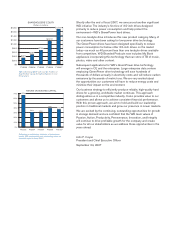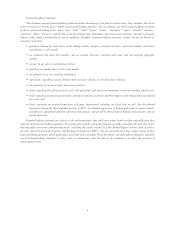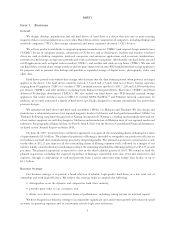Western Digital 2007 Annual Report Download - page 16
Download and view the complete annual report
Please find page 16 of the 2007 Western Digital annual report below. You can navigate through the pages in the report by either clicking on the pages listed below, or by using the keyword search tool below to find specific information within the annual report.2007, we began shipping 3.5-inch hard drives with 188 GB per platter areal density and 2.5-inch hard drives with
125 GB per platter areal density. In July 2007, we introduced the WD Cavier»GP 3.5-inch hard drive which has 250 GB
per platter areal density.
Head technology is one of the variables affecting areal density. Historically, there have been rapid technological
changes resulting in several generations of head technology in a relatively short time. However, in recent years the time
has lengthened between changes in generations of head technology. The hard drive industry is in the midst of a transition
from the use of giant magnetoresistive head technology for the head writer function to perpendicular recording (“PMR”)
technology, which allows for significantly higher storage capacities. In addition, the industry is making the transition to
tunnel injunctive magneto resistive (“TMR”) technology for the head reader function. We have essentially completed the
transition to PMR and TMR in our 2.5-inch products and we are in the midst of these transitions in our 3.5-inch
products.
The WD product line generally leverages a common platform for various products within product families with
different capacities to serve differing market needs. This platform strategy results in commonality of components across
different products within product families and, in some cases, across product families, which reduces exposure to changes
in demand, facilitates inventory management and allows us to achieve lower costs through purchasing economies. This
platform strategy also enables our customers to leverage their qualification efforts onto successive product models.
In addition to the development of hard drives, we invest considerable resources in the development of head
technology used in the majority of our hard drive products and we anticipate investing considerable resources in the
development of media technology following our planned acquisition of Komag. The design and manufacturing of WD
heads consists of engineering and fabricating a read element for reading data from media, a write element for writing data
to media, and slider. The slider functions like an airplane wing and allows the read and write elements to fly over the
surface of media and to land, on either the media or a special ramp, when power is not applied to the hard drive.
Fiscal 2007 represented the fifth consecutive year of substantial growth in our research and development and capital
spending to support our significant broadening of our product and technology portfolios. Over that five-year period, we
have grown our investment spending over 270% from $170 million in fiscal 2002 to approximately $630 million in
fiscal 2007. As a result of this investment activity, we continue to expand our business beyond the desktop market into
newer markets or markets in which we have not previously participated. Such investments have allowed us to execute
against our strategic objective of revenue diversification to address the growth of new applications for hard drives and
fast-growing new market opportunities.
We are currently expanding our existing head wafer fabrication facilities to accommodate our anticipated growth.
The expansion will involve a process change to utilize 8.0-inch wafers from 6.0-inch wafers and will cost an estimated
$400 million in the fiscal 2008 to 2010 timeframe. This will be in addition to our ongoing capital expenditures for hard
drive and head assembly, and our anticipated capital expenditures for media development and manufacturing following
our planned acquisition of Komag.
For an additional discussion of risks related to technological innovations, see Item 1A of this Annual Report on
Form 10-K.
Sales and Distribution
We sell our products globally to OEMs, ODMs, distributors and retailers. OEMs purchase our hard drives, either
directly or through a contract manufacturer such as an ODM, and assemble them into the computer or other CE systems
they build. Distributors typically sell our hard drives to non-direct customers such as small computer and CE
manufacturers, dealers, systems integrators, online retailers and other resellers. Retailers typically sell our hard drive
products directly to end-users through their storefront or online facilities.
Original Equipment Manufacturers
Sales to OEMs, which include sales through ODMs, accounted for 48%, 54% and 58% of our revenue in 2007, 2006
and 2005, respectively. During 2007, our largest OEM customer was Dell. During 2007, 2006 and 2005, sales to Dell
accounted for 10%, 12%, and 16%, respectively, of our revenue. We believe that our success depends on our ability to
maintain and improve our strong relationships with the leading OEMs.
10
























